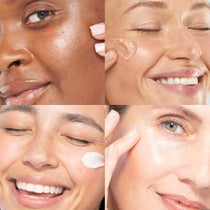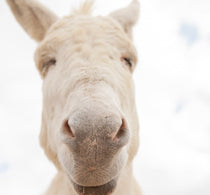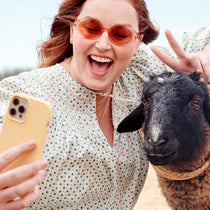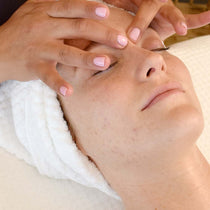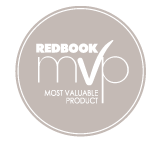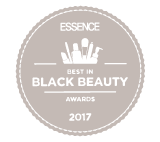Donkey Acupuncture With Dr. Grand
Meet Dr. Grand - A Rare Veterinarian Who Combines Eastern & Western Medicines To Heal Our Loved Ones
Do you roll your eyes when you hear “acupuncture”? Do you write it off as too “woo-woo” for you? Our vet, Dr. Teleah Grand, will change your mind. Dr. Grand visited for a hot afternoon session of acupuncture on the hill with Granny, our 20-something-year-old donkey. Granny is elderly, but age isn’t what’s troubling her. Granny has severe arthritis and laminitis in her hoof where her bone actually turns downward, which can make it incredibly painful to walk. We decide daily whether to give her a scoop of Bute (donkey Tylenol) by judging Granny’s quality of life: - Is she walking with very little limp? - Can she walk up our acres of hillside? - Is she feisty? Hanging with the herd?
After her 1st session of acupuncture, we have been able to reduce her medication. We’re moving on to session #2. And we’re adding special foods and herbal therapies prescribed by Dr. Grand, using Traditional Chinese Veterinary Medicine’s multimodal approach to help her not only have less pain, but more energy.
This Amazing Vet Will Change Your Mind About Acupuncture
Teleah M Grand, DVM, CVA, CVFT, CVCH, CVTP | ANIMAL CARE CENTER @STONEBRIDGE RANCH, MCKINNEY, TEXAS | visit website.
Dr. Teleah Grand has been a practicing veterinarian for over 23 years. She earned her degrees from Texas A & M and the Chi Institute of Traditional Chinese Veterinary Medicine (TCVM) in Reddick, Florida (1 of only 3 education programs in America teaching Veterinary Acupuncture). She is a RARE find and a gift to the animal world, combining both Western AND Eastern Medicine practices to treat her patients.
"ACUPUNCTURE TREATS PAIN, YES; BUT IT IS A POWERFUL TOOL TO TREAT ANY DISEASE, FROM ENDOCRINE DISEASES, TO CANCER. FROM AUTOIMMUNE DISEASES, TO ARTHRITIS. MORE IMPORTANTLY, IT CAN HELP BALANCE THE BODY TO PREVENT DISEASE. IT IS A PATH TO WELLNESS, NOT JUST TREATING SYMPTOMS OF DISEASE."
A Fascinating Interview With Dr. Grand:
1. How/why did you get started as a veterinarian? I’ve wanted to be a veterinarian since I can remember. Reading the “All Creatures Great and Small” series by James Herriot sealed the deal. However, when I reached college age, I found out how difficult it was to get into veterinary school. Acceptance rates are only about 10%.
I was encouraged to get a degree in a profession that was more marketable and discouraged from pursuing a dream that was difficult to achieve. So, I caved. I got my degree in Electrical Engineering. I worked as an engineer after college (Geaux Tigers) for 4 years and became increasingly unhappy in my job. Driving through the countryside near Charlottesville, Virginia while interviewing for a new job, I realized that a new job wouldn’t solve my unhappiness. I wanted to be a veterinarian, not an engineer.
So, I decided to give it a try. I went back to college for prerequisite undergraduate classes, knowing that if I could not get into vet school, at least I tried. Fortunately, I loved the classes; excelled in them, and got admitted to the Texas A&M College of Veterinary Medicine (Gig’em Aggies) on my first application. Four years later, I received my Doctor of Veterinary Medicine (DVM) and was a practicing veterinarian. 23 years later, I still love my career and do not, for a single second, regret starting over.
2. Why did you decide to pursue both Western and Easter medicine? Is this rare? As the years went by, I found myself saying more and more to my clients “I’m sorry, there's nothing more that can be done”. I had to look into their pet’s eyes. Eyes that still had spark, still had energy and spirit. And say, “There is nothing I can do for you”. Euthanizing pets, especially elderly pets, became increasingly difficult for me.
These pets were not done with life. You could see it in their eyes. But they were suffering. So, I set out to learn what I can do to help them. I thought acupuncture would be a good solution. Another valuable tool to help my patients. Mainly, I thought it would help ease pain and suffering. I didn’t have any idea that pursuing a certification in acupuncture would lead me to an entire new way of, not just relieving pain and suffering, but identifying and treating all diseases.
There are only three education programs in the country that teach veterinary acupuncture. They last for 6-9 months of online and onsite classes. They are intensive, expensive and difficult. After the classes, you must pass rigorous testing, practical exams and present case reports in order to be certified in veterinary acupuncture. The only students allowed to take the course are graduates of a college of veterinary medicine or veterinary students in their last year of veterinary school.
I chose to go to the Chi Institute in Reddick Florida. The Chi Institute, founded and headed by Dr Huisheng Xie, teaches acupuncture applied in the method of Traditional Chinese Veterinary Medicine. Not only do we learn acupuncture, but we learn an entire ancient approach to diagnosing and treating disease… Eastern medicine; consisting of TCVM pattern diagnosing and methods to treat those patterns with acupuncture, herbal therapy, food therapy, and Tui na or massage therapy.
During my acupuncture class, I fell in love with Traditional Chinese Veterinary Medicine. I became a better and more observant practitioner of medicine in general, but I all the sudden learned why eastern medicine is also called “complementary” medicine. It complements, not interferes, with western medicine.
It’s much bigger and much more robust than just treating pain, which is what I, and many veterinarians, viewed acupuncture as…. Simple treatment for pain. Acupuncture treats pain, yes; but it is a powerful tool to treat ANY disease, from endocrine diseases, to cancer. From autoimmune diseases, to arthritis. More importantly, it can help balance the body to prevent disease. It is a path to wellness, not just treating symptoms of disease.
3. What do you like most about performing Eastern medicine? There seem to be three levels of disease and therapies. The first is superficial. This is an easily recognizable and treatable condition, such as a broken bone, an ear infection. The second level is more of a systemic level. This one needs more diagnostic testing and possibly even secondary testing to diagnose and the treatment becomes more complicated. Examples are Diabetes Mellitus, Chronic Hepatitis, Inflammatory Bowel Disease, and Cushing’s disease. They can be difficult to diagnose but the result is ultimately a diagnosis and a treatment plan.
The third level is the deep whole-body level. At this level, there are symptoms, yet veterinarians cannot identify an exact disease or cause of the symptoms. We know these pets are having lower quality of life, yet we have no concrete answers as to why, nor do we have a clear-cut treatment plan. An example of this is Granny. She has arthritis, she has a recurrence of laminitis which isn’t a current issue but may be in the future, she is weak, she is losing muscle mass, she probably has a difficult time keeping warm (which is why we had to treat her in the middle of a sunny field in July), she is stiff, she is sore, she probably cannot hear well. Many would say she is just old and these symptoms come with age, but do they have to? At the superficial level, if you want something fixed fast… Western medicine is the one to reach for. Having said that, eastern medicine can be used from a young age to help the body work better, help the immune system be stronger, help prevent disease.
Western medicine is what I call “anti” medicine. We have Antibiotics, Anti-inflammatories, Anti-fungals, Anti-parasitics, Anti-nausea medications and Anti-diarrheals. We can surgically correct fractured bones, repair tendons and ligaments, we can remove masses and tumors. We can even kill cancer with chemotherapy, radiation and remove it with surgery. Western medicine, when used correctly is a powerful tool to treat and to cure.
Eastern medicine works better to balance the body to prevent disease. Medicine, in general, gets more complicated at the systemic level. We can diagnose and manage some chronic diseases very well with western medicine. But this is where we start to see side effects of our therapy, we start to see co morbidities. We see chronic recurrence of symptoms. We start to see imbalance. We can start to see our patient develop deficiencies and start to decline in their quality of life.
This is the level where eastern and western medicine can really complement each other. They work together to use the powerful tools of western medicine to manage and cure, and eastern medicine to balance the body in order to either reduce the side effects of medicine, reduce the western medicine needed to manage the disease, or in some cases, increase the ability to get off western medicine completely. At this point we can really choose the most powerful tool or multiple tools to help us have better health and wellbeing.
Western medicine does not do a good job at addressing or even identifying problems at a deeper level. At the deep level, we know there is a problem, there is lack of energy, there is the inability to regulate body core temperature, there is ongoing pain. There are comorbidities and multiorgan problems. There is suffering. This is also where we see terminal diseases that all we can do in western medicine is “keep them comfortable”.
This is where eastern medicine really shines. It defines deficiencies in the body and gives us tools to tonify those deficiencies. It brings up the quality of life. It relieves what in western medicine we refer it to as nonspecific symptoms. This is where we can really help Granny feel better, by tonifying her deficiencies and thereby relieving pain and suffering. It’s not just about keeping her comfortable. It’s about increasing her energy, her stamina, and having her enjoy life.
And it starts with balance. If imbalances can be identified and treated, then good quality of life results. The main reason I love eastern medicine so much is that for the first time in my career, I can identify these imbalances AND I can treat it. It is so gratifying to be able to see pets with chronic pain and disease, start to play, go on walks and enjoy life again.
4. Is there a big misconception when it comes to Eastern medicine? What is something the western culture could benefit from in eastern practices? I think there are two misconceptions about eastern medicine. The first is that eastern medicine only includes acupuncture and only treats pain. TCVM and acupuncture are wonderful at treating pain. But used in conjunction with herbal therapy, food therapy and Tui na. Any disease can be treated, managed and sometimes cured.
The second misconception is that there is no scientific data that supports the efficacy of eastern medicine. It is looked at as having no scientific basis, no proof that it works. Yet there are scientific studies that show acupuncture is as effective at blocking mu receptors (nerve pain receptors) as opiods. Studies show herbal formulas not only support cancer patients through chemotherapy with better outcomes, but patients maintain weight and feel better during cancer therapy. There is scientific evidence that using specific diets, you can treat anything from arterial sclerosis to acne. There is data proving scientifically that there is a systemic cortisol reduction and endorphin release from a tui na or medical massage therapy.
There are more ways to managing disease other than surgery and pharmaceuticals. There is a deeper way to identify and address disease that is a more whole-body approach. TCVM works to balance imbalances in the body, mind and spirit that are leading to disease. This leads to better prevention of disease and less suffering during disease. Western medicine is reactionary. TCVM is proactive.
5. For someone not familiar with eastern medical practices, what is the most commonlyused treatment? For animals and for humans? Most people have either heard of or know someone who has had acupuncture to relieve pain. Twelve years ago, I ruptured the cranial cruciate ligament in my knee. I had surgery to correct it, but my knee was never the same. I had pain. All. The. Time.
My western solution was more surgery. I chose to try acupuncture instead. Six months of acupuncture and my knee (which will never be right because I did rupture my cruciate ligament) is mostly pain free and more flexible than it had been since the original surgery. The pain recurs every now and then, when the weather changes, or if I reinjure it. But acupuncture makes it better in 1-2 sessions. No surgery. No chronic use of pain medications. Lower medical bills. No recovery time off work.
Animals and humans are not as different as people think when it comes to any medicine. Whether it’s eastern or western. Veterinarians perform the same or similar diagnostics, surgery and medical management of mostly the same diseases of humans. There are species differences to learn, of course. But we are not as different as it seems. Acupuncture points, herbal formulas, and diet changes can be easily applied to any species. A colleague recently presented a case using acupuncture in a koi fish. Another uses acupuncture and herbs on penguins in a zoo. There are pictures presented at the Chi Institute of acupuncture, herbal therapy and food therapy being used on elephants, horses, giraffes. Once in class, we had a chicken who was egg bound – she could not lay her egg. One acupuncture needle later and she calmed down, squatted, out popped her egg. We are all living creatures. We all can suffer from pain and disease. We all can benefit from Traditional Chinese Medicine.
6. What would the most surprising thing be for our customers to know, about the benefits from your services? I think what surprised me most about TCVM is the power of herbal formulas and food therapy, and the healing of simple Tui Na (massage). Identifying simple diet changes and using ancient herbal formulas that work synergistically improves energy and health. Today, I tend to use more diet changes and herbal formulas to treat my patients. I teach my clients how to use massage for more intentional petting. I still use acupuncture. But I’ve learned a topographical or balancing method acupuncture, so I can get results with 1-2 needles instead of 10. I have seen patients go from being low energy with a low quality of life to playful and active. It’s fun to see a 17-year-old dog bouncing through the yard playing with her brother and chasing rabbits. When 2 years previously she could barely climb the stairs, coughed all night, and slept most of the day. All I changed was her food, added herbal supplements, and did a few sessions of acupuncture. With no western medications at all, I increased her quality of life.
7. Do you have a favorite animal you like to work with? Or a favorite story of health and healing from the animals you've worked with? Horses are honest. They will be frank about what is wrong and where it hurts. So, when you help them, and usually it only takes 1-2 needles, they show immediate visible improvement. Horse are so satisfying to diagnose and treat using TCVM. Unfortunately, I don’t treat horses in my practice currently. I’d like to change that in the future. Dogs are my primary patients, and I adore them. But dogs can be such people pleasers, that sometimes it’s difficult to get honest information from them. When you treat them, they’ll give you mixed signals as to whether they feel better or not. I think sometimes dogs can act like they don’t feel better just for the attention. Very mixed signals
Cat’s? Well, cats are honest. Brutally honest. They’d rather mentally flip you off than tell you anything. So, they can be more than a little frustrating to diagnose and treat. But cat’s do respond well to TCVM therapy. And they’ll begrudgingly give you positive feedback.
One of my cat patients literally went up a wall and around the room after I put 3 needles into her. But they were good needles. They helped her feel better. The next visit, she curled up on the table and took a nap while I needled her; because, while she wasn’t happy about it, she knew I was helping. I imagine she still was flipping me off in her head, though.
8. What would you say is a common misconception about your job? Veterinary medicine as a career, is brutal. Veterinarians have the highest suicide rate of any profession. Most of us suffer from physical, emotional, mental and financial exhaustion. Somedays, it’s only one. Some days it’s all of them. Student debt and low salaries are a major problem in the veterinary profession. Compared to the length of our education, we are paid a fraction of what other medical professionals make. Yet, most of us would still choose veterinary medicine. It is more of a calling than a career.
Emotionally, we must go from delivering a terminal diagnosis and educating our clients on quality of life issues in one room, to vaccinating a puppy in another. Physically? Let’s just say some days it takes 3-4 people to be able to simply trim toenails. Our patients are rarely cooperative, and while we try to keep them fear free and use gentle restraint techniques, our patients can be very strong when it comes to trying to get away from us or attempting to get us away from them.
Mentally, we have patients that literally can’t speak and tell us what is wrong, so diagnosing and identifying disease is extremely frustrating and challenging. Veterinary medicine is not just about playing with puppies and kittens. We diagnose, we perform surgery… We are radiologists, internists, dentists and dermatologists. We have patients that we follow from birth to death. Our days are rollercoasters of highs and lows. It’s exhausting. I wouldn’t trade it for the world. But I must be very careful to maintain high levels of self-care in order to continue to do what I love.
9. What is the most challenging thing about working in your field? Knowledge. The continuing evolution and advances in the knowledge of medicine and the practice of medicine are challenging to keep up with. It’s knowing that for every 10 new things you learn, there are 100 more that you need to learn before you feel comfortable in your knowledge. It’s like the more you know, the more you realize how little you do know. It’s learning, reading and researching every single day and knowing that there is so much more to learn. It’s knowing that your best is good, but wondering if it will ever be good enough.
10. What is the most rewarding? When your best is good enough. And you can look at your client and your patients and see happiness, joy and health.
11. What advice would you offer someone wanting to look into finding someone like you where they live? Are there any pointers or things they should expect and not be surprised by? The Chi Institute (TCVM.com) has a provider finder on their website to direct people to veterinarians who have taken classes and received one of many TCVM certifications in acupuncture, herbal therapy, food therapy, Tui Na, among others. The American Association of Veterinary Acupuncture (AAVA.org) and the American Holistic Veterinary Medical Association (AHVMA.org) both have provider finder for veterinarians that practice holistic veterinary medicine and acupuncture.
The best way to find a provider is a simple internet search. Look for keywords, TCVM, or acupuncture, holistic, alternative, homeopathic, integrative and complementary plus veterinary medicine. Most veterinarians who practice complimentary medicine will have a website or social media accounts. Veterinarians who practice Integrative Veterinary Medicine want to be found. We want to help you help your pets.
I would encourage people to find a licensed veterinarian in their area that is either certified in an area of alternative therapy or who is getting certified. There are people who do not have DVM degrees practicing alternative veterinary medicine. There are even licensed veterinarians who are attempting to practice telemedicine - or long-distance medicine. I cannot stress enough the importance of hands on examination and diagnostics in veterinary medicine, especially complementary medicine. I think it is imperative to find a veterinarian who has the education and knowledge to practice good veterinary medicine, and who has the passion and skill to practice alternative medicine.
12. What is wrong with Granny? And how can acupuncture help her? Granny is old, very old. One of my favorite professors said that old age is not a disease. Yet, many times a day, when I ask if how a pet is doing, I hear “They are old” as if it’s expected that your pet can’t have an active, happy life once they reach a certain age. That it’s expected for them to slow down, to become weaker, duller, painful. I disagree with that sentiment. It is true that old age brings a certain wearing out of organ function, and body parts. It brings deficiency. Slowness, weakness, chronic disease and pain. But it doesn’t have to. If a specific deficiency can be identified, then it only logically follows that that deficiency can be tonified.
Granny’s TCVM pattern diagnosis is Kidney Qi deficiency, Spleen Qi deficiency, Bony Bi Syndrome. That sounds weird, and most western trained veterinarians would not know what that even means. They would diagnose her as simply arthritic and painful which is the Bony Bi part of the TCVM diagnosis. But there is more than just pain. Granny is weak, she’s losing muscle tone, she’s slower, her energy level is low AND she’s painful. The kidney meridian controls the urogenital system, and bones. The spleen meridian controls the muscles. Qi can be defined as energy within the body.
So, Granny lacks energy in her joints, muscles. Really, Granny lacks energy in her whole body. She probably gets cold very easily. Ever see those aged mothers and grandmothers that always wear sweaters to keep warm? They lack Qi. They are Qi deficient. They lack the energy to warm up. Bony Bi is also defined in TCVM as Qi stagnation. The Chinese say where Qi stagnates there is pain. Think of Qi stagnation like a traffic jam. Nothing is moving. Pretty painful, right? Where Qi does not move, pain results. Granny has a deficiency of her Qi, and what Qi she has, is stagnant.
Western therapy for Granny is mainly aimed at using pharmaceuticals for pain control. Pain control is not a bad thing, but it will do nothing to tonify her deficiencies, to give her more energy.
In eastern medicine we can not only treat pain, but we can tonify her Qi, specifically her Kidney and Spleen Qi using food therapy, herbal therapy, and acupuncture. We also can move Qi in order to relieve stagnation and pain. When Qi moves, there is more energy, better flow, healthier function and no pain. TCVM is a multimodal approach to helping her not only have less pain, but more energy. More Qi and better movement of Qi.
13. Five fast personal questions
Favorite movie or TV show: I have a weird obsession with reality TV shows and anything HGTV Favorite restaurant: Patina Green in downtown McKinney. Their soups and sandwiches are food for the soul.
Favorite activity on your day off: What is a day off? ;-)
Favorite day of the week: Saturday afternoons…. Refresh time.
Favorite piece of advice: “LIVE AS IF YOU WERE TO DIE TOMORROW. LEARN AS IF YOU WERE TO LIVE FOREVER.” - MAHATMA GANDHI.



